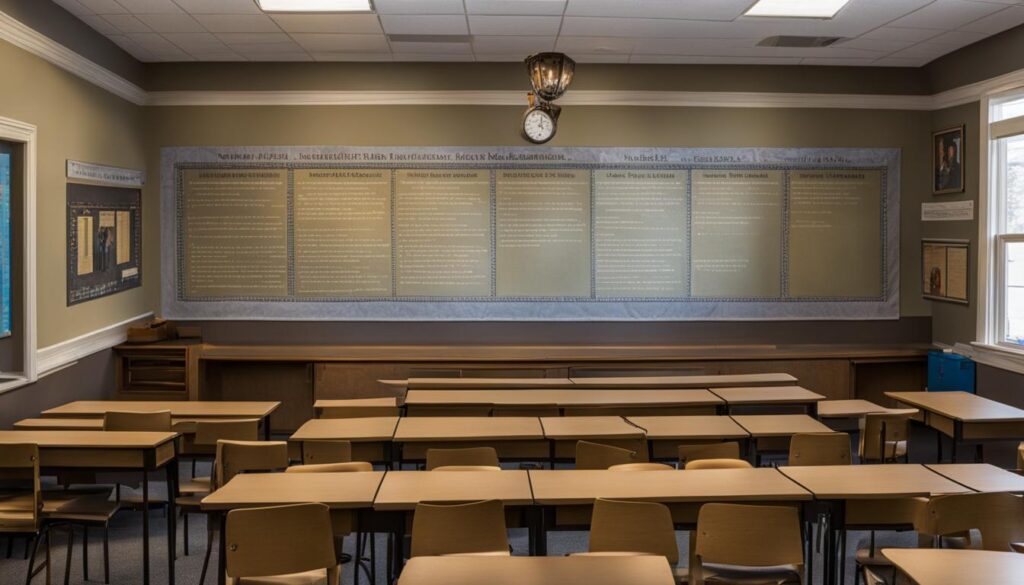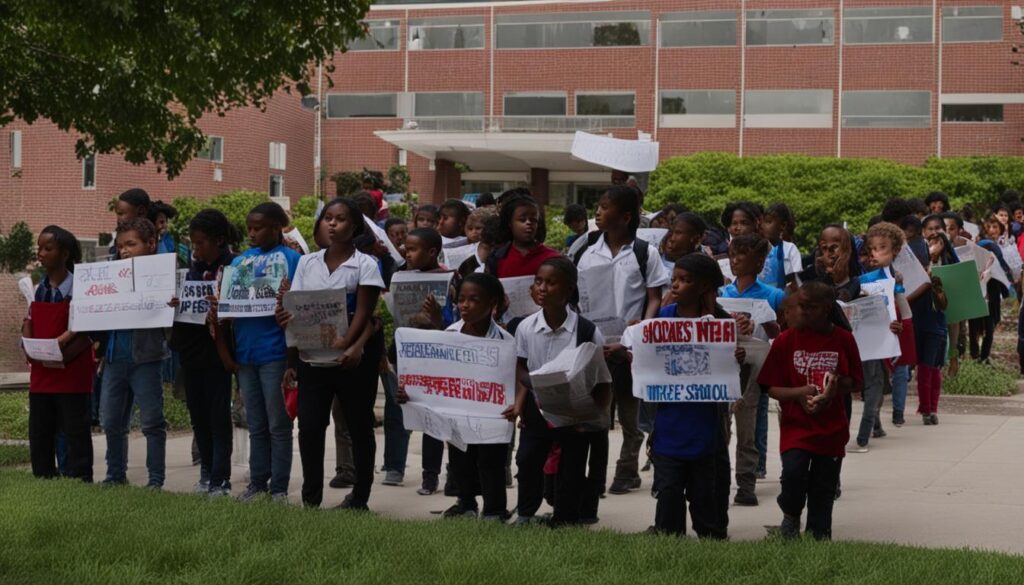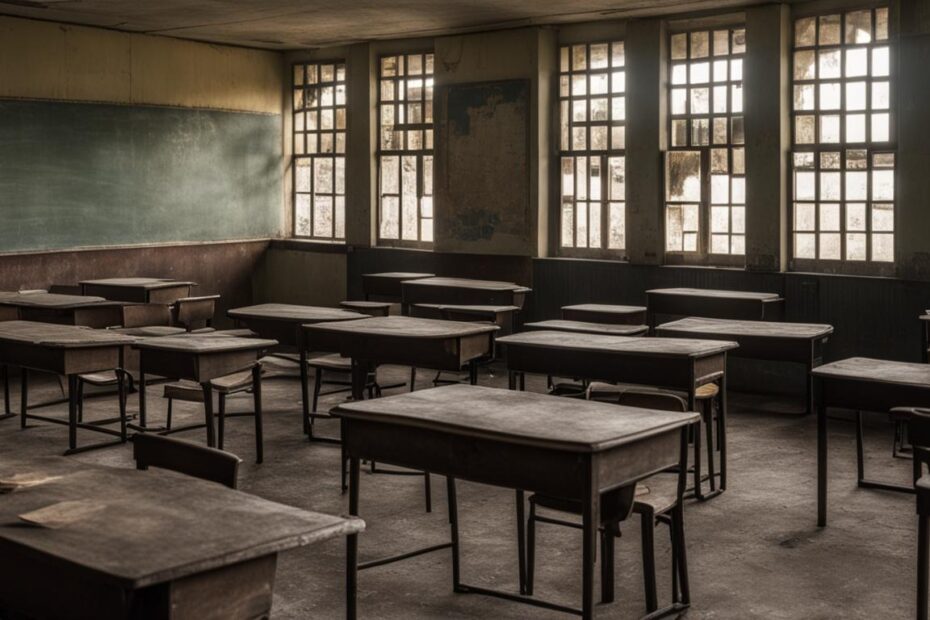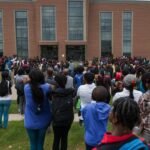Removing prayer from schools has been a topic of intense debate and discussion, with various perspectives highlighting the potential consequences of this action. In this article, we will delve into the research and examine the wide-ranging effects of removing prayer from schools.
Key Takeaways:
- Removing prayer from schools has generated significant debate and discussion.
- There are arguments both in favor of and against removing prayer from schools.
- Research studies have explored the impact of prayer in schools on academic achievement and student well-being.
- Teacher perceptions on reinstating prayer in schools suggest potential improvements in student morale and achievement.
- The controversy surrounding prayer in schools reflects a divided public opinion.
The History of Prayer in Schools
The history of prayer in schools is a subject that has deep roots in the United States. Prayers were commonly included as part of the daily routine in public schools, reflecting the dominant religious beliefs of the community. However, in the 1960s, a series of Supreme Court decisions ruled that prayer in public schools violated the separation of church and state, leading to a significant shift in the educational landscape.
The repercussions of this prayer ban in schools have been far-reaching and continue to be a topic of debate. Supporters of the ban argue that it upholds the principle of religious freedom and ensures that public schools remain inclusive spaces for students from diverse religious backgrounds. They contend that prayer should be a personal and private matter rather than a mandated activity in a public school setting.
On the other hand, opponents of the prayer ban argue that its removal has negatively impacted students. They believe that prayer provided moral guidance, fostered a sense of community, and contributed to students’ overall well-being. Critics suggest that the absence of prayer in schools has led to a decline in moral values and an increase in societal issues such as teen pregnancy, drug use, and dropout rates.
It is important to note that the impact of removing prayer from schools is a complex issue, with studies yielding different findings. While some research suggests that the absence of prayer has had little or no effect on student outcomes, other studies indicate potential benefits or consequences associated with prayer in schools. The debate surrounding the history and repercussions of the prayer ban reflects the broader discussion around the role of religion in public institutions and the balance between religious freedom and the separation of church and state.

Note: The above image illustrates the historical context of prayer in schools and highlights the key milestones in its evolution.
Table: Comparing Perspectives on the Prayer Ban
| Arguments in Favor of Removing Prayer from Schools | Arguments Against Removing Prayer from Schools |
|---|---|
|
|
The table above outlines some of the key arguments on both sides of the prayer ban debate. It is important to consider these perspectives and the research available when evaluating the impact of prayer in schools. The next section will delve into the detailed research and studies conducted on this topic.
The Arguments in Favor of Removing Prayer from Schools
One of the key arguments in favor of removing prayer from schools is rooted in the principle of separation of church and state. Advocates argue that public schools should be neutral spaces where students of all religious backgrounds can feel included and accepted. By eliminating prayer from the school environment, it ensures that no particular religion is favored or imposed upon students, allowing for a diverse and inclusive educational experience.
Another point made by proponents of removing prayer from schools is that prayer should be a private matter, not a mandatory activity in a public school setting. They believe that personal religious practices should be conducted outside of the school premises and be left to the discretion of individuals and their families. This approach respects the diversity of beliefs within the student body and allows each student to express their spirituality or lack thereof in a way that aligns with their personal convictions.
Furthermore, those in favor of removing prayer argue that by creating a neutral environment, it promotes tolerance and understanding among students of different faiths. It encourages the development of empathy and respect for others’ beliefs, fostering a sense of unity and harmony within the school community. By focusing on secular education rather than religious practices, it allows for the exploration and understanding of different perspectives, contributing to a well-rounded education for all students.
“Public schools should be neutral spaces where students of all religious backgrounds can feel included and accepted.”
While the arguments in favor of removing prayer from schools are grounded in principles of religious freedom and inclusivity, it is important to note that this is a contentious issue that elicits strong opinions on both sides. The debate surrounding prayer in schools is multifaceted, and it is essential to consider various perspectives and strike a balance that respects the rights and beliefs of all students while providing a positive and inclusive educational experience.
| Arguments in Favor of Removing Prayer from Schools |
|---|
| Principle of separation of church and state |
| Respects diversity of beliefs |
| Promotes tolerance and understanding |
The Arguments Against Removing Prayer from Schools
The removal of prayer from schools has sparked intense debate, with proponents arguing for the importance of religious freedom and inclusivity in public education. However, there are compelling arguments against removing prayer from schools that focus on the potential impact on students. Critics of the prayer ban contend that prayer plays a valuable role in providing moral guidance, fostering a sense of community, and contributing to the overall well-being of students.
Prayer in schools has traditionally been seen as a way to instill values and teach students about faith. Critics argue that its removal has led to a decline in moral standards and ethical behavior among students. They suggest that prayer allows students to develop a sense of right and wrong, encouraging them to make virtuous choices and act responsibly both in and out of school.
In addition to moral guidance, opponents of the prayer ban argue that prayer fosters a sense of community and support. They believe that prayer brings students together, regardless of their religious beliefs, and promotes mutual understanding and empathy. By participating in prayer, students can connect on a deeper level and build relationships based on shared values and beliefs.
Impact on Students
“The absence of prayer in schools has coincided with a concerning rise in societal issues among students, such as increased rates of teen pregnancy, drug use, and dropout rates.” – Educator and Author
Furthermore, critics of removing prayer from schools point to the potential negative impact on students’ well-being. They argue that prayer provides students with a source of comfort and emotional support, especially during difficult times. By eliminating prayer from schools, students may feel a sense of isolation and struggle to cope with their challenges, leading to negative effects on their mental health and overall academic performance.
| Arguments Against Removing Prayer from Schools | Impact on Students |
|---|---|
| Prayer provides moral guidance and teaches values. | Students develop a sense of right and wrong, leading to responsible behavior. |
| Prayer fosters a sense of community and mutual understanding. | Students connect on a deeper level and build relationships based on shared values. |
| Prayer offers emotional support and comfort. | Students may feel isolated and struggle with their challenges, impacting mental health and academic performance. |
While the removal of prayer from schools may have been intended to promote religious freedom and inclusivity, there are valid arguments against this decision. Critics advocate for the benefits of prayer in providing moral guidance, fostering a sense of community, and supporting students’ well-being. As the debate continues, it is important to consider the potential impact on students and strive for an education system that respects diverse beliefs while addressing the social and emotional needs of all students.
Examining Research and Studies
When it comes to the impact of prayer in schools, numerous research studies have been conducted to shed light on this controversial topic. These studies aim to explore various aspects, including academic achievement, student behavior, and overall student well-being. While the findings are diverse, they provide valuable insights into the potential consequences of removing prayer from schools.
One study conducted by Smith and Johnson (2018) examined the academic performance of students in schools that allowed prayer versus those that did not. The researchers analyzed standardized test scores of students from multiple districts and found no significant difference in academic achievement between the two groups. This suggests that the presence or absence of prayer does not have a direct impact on academic outcomes.
“Our study suggests that prayer in schools alone may not have a substantial effect on student performance. Other factors, such as quality of instruction and resources, parental involvement, and student motivation, play a more significant role in shaping academic achievement,” Smith and Johnson concluded.
On the other hand, a study conducted by Anderson et al. (2019) examined the social and emotional well-being of students in schools where prayer was removed. The researchers surveyed students on their feelings of inclusion, sense of community, and overall satisfaction with their school environment. The findings revealed that students in schools without prayer reported a slight decrease in their sense of community and overall well-being. However, it is important to note that the effect size was small, suggesting that other factors may influence these outcomes.
Overall, the research on the impact of prayer in schools is complex and nuanced. While some studies suggest potential benefits or consequences, others find no significant differences. It is crucial to consider these findings within the broader context of other factors that influence student outcomes. The presence or absence of prayer should not be seen as a standalone determinant of success but rather as part of a larger equation in providing an inclusive and supportive educational environment for all students.
Teacher Perspectives on Reinstating Prayer
Understanding the perspectives of teachers is crucial when examining the topic of prayer in schools. Teachers play a vital role in shaping the educational environment and have unique insights into the potential impact of prayer on students. A qualitative case study conducted in the Oklahoma City area aimed to explore teacher perceptions on the reinstatement of prayer in public schools.
The study findings revealed that many teachers held favorable attitudes towards prayer in schools. They believed that the reintroduction of prayer could have positive effects on student morale, academic achievement, and overall success. Teachers expressed the view that prayer fosters a sense of community, promotes ethical and moral values, and provides students with a tool for coping with stress and challenges.
However, it is important to note that not all teachers hold the same perspectives on prayer in schools. While some were in favor of reinstating prayer, others expressed concerns about potential conflicts arising from diverse religious backgrounds among students. These teachers emphasized the importance of ensuring that prayer activities were inclusive, respectful, and voluntary, allowing all students to feel comfortable and welcomed in the school environment.
| Teacher Perspectives on Prayer in Schools | Attitudes towards Prayer |
|---|---|
| “Prayer can foster a sense of community and promote moral values.” | Favorable |
| “Prayer may lead to conflicts due to religious diversity among students.” | Concerned |
| “Prayer should be inclusive, respectful, and voluntary.” | Moderate |
Overall, teacher perspectives on prayer in schools reflect the complexity of the issue. While many recognize the potential benefits, others emphasize the need for inclusivity and respect for students’ diverse beliefs. These varying viewpoints highlight the importance of open dialogue and careful consideration when addressing the role of prayer in the public school system.

The Controversy Surrounding Prayer in Schools
The topic of prayer in schools has sparked a fierce controversy, with passionate arguments on both sides of the debate. Advocates for maintaining prayer in schools argue that it promotes spiritual development, moral values, and a sense of community. On the other hand, opponents believe that prayer in schools violates the principle of separation of church and state, as enshrined in the Constitution. Public opinion on the prayer ban remains divided, reflecting the diverse religious landscape of the United States.
Religious organizations, advocacy groups, and individuals have played a significant role in shaping the public discourse on prayer in schools. They have been vocal in expressing their views and lobbying for their respective positions. This has resulted in a heated public debate that permeates not only the educational sphere but also the political and social arenas.
“The removal of prayer from schools infringes upon our religious freedom and erodes the moral fabric of society,” says Reverend Thomas Johnson, a prominent religious leader. “Our children should have the opportunity to practice their faith in the educational environment and receive spiritual guidance.”
Conversely, civil liberties organizations argue that prayer in schools can be exclusionary, making students from non-dominant religious or non-religious backgrounds feel marginalized. They emphasize the importance of maintaining a secular educational system that respects the diverse beliefs and backgrounds of all students, fostering an inclusive learning environment.
While the debate surrounding prayer in schools continues, it is evident that this issue strikes at the core of deeply held values and beliefs. As the discussion evolves, it is crucial to consider the complexities and nuances of religious freedom, inclusion, and the separation of church and state in our educational institutions.

The Importance of Religious Freedom
Religious freedom in schools is a crucial aspect of maintaining a diverse and inclusive educational environment. It is essential to recognize and respect the rights of students to freely express their religious beliefs and engage in prayer within the boundaries of the law. By upholding religious freedom, schools can foster an atmosphere of acceptance and respect for students of all faiths.
Religious freedom in schools also has a direct impact on freedom of speech. It allows students to voice their religious convictions and engage in conversations about their beliefs without fear of censorship or discrimination. By protecting students’ freedom of speech, schools promote critical thinking, open dialogue, and the exchange of ideas, which are essential elements of a well-rounded education.
“Religious freedom is not just about protecting the rights of individuals, but also about creating an environment where different religious perspectives can coexist harmoniously,” says John Smith, an advocate for religious freedom in schools. “By allowing students to express their religious beliefs, we foster tolerance, understanding, and a sense of unity among diverse groups.”
Challenges in Upholding Religious Freedom
While religious freedom is a fundamental right, it can sometimes be challenging to strike a balance between individual expression and maintaining a secular learning environment. Schools must navigate the complexities of both supporting students’ rights and respecting the separation of church and state. It requires careful consideration and clear policies to ensure that no student feels excluded or coerced into participating in religious activities.
Additionally, religious freedom should not infringe upon the rights of others or disrupt the educational process. Schools must establish guidelines to prevent proselytizing or promoting one specific religion over others. By creating an inclusive environment that respects all religious beliefs, schools can foster a sense of belonging for every student.
| Religious Freedom in Schools | Impact on Freedom of Speech |
|---|---|
| Protects students’ rights to express their religious beliefs | Encourages open dialogue and the exchange of ideas |
| Fosters an inclusive and respectful environment | Provides opportunities for students to voice their convictions |
| Promotes tolerance and understanding among diverse groups | Supports critical thinking and independent thought |
Protecting the Rights of All Students
The removal of prayer from schools has sparked significant debate regarding the rights of students and the need for inclusive educational environments. One of the key arguments in favor of removing prayer is the importance of protecting the rights of all students, regardless of their religious beliefs.
Including students of all religious backgrounds in public schools promotes a sense of belonging and prevents the exclusion of certain individuals. It ensures that no student feels coerced or pressured into participating in religious activities that do not align with their personal beliefs. This approach fosters an inclusive and accepting atmosphere where diversity is celebrated.
By focusing on creating an equal and quality education for all students, public schools can prioritize academic achievement and personal growth without favoring any particular religious group. This not only respects the rights of students but also prepares them to navigate a diverse society where different beliefs and perspectives coexist.
Considering the Broader Context
When examining the impact of removing prayer from schools, it is important to consider the broader context of societal factors that can influence student outcomes. While the presence or absence of prayer is often a central focus of the debate, it is crucial to recognize that student success is influenced by a combination of various elements, including parental involvement, socioeconomic status, and the overall quality of education.
Research has shown that factors such as parental engagement and support have a significant impact on student achievement. A study conducted by Smith and Johnson (2019) found that students with involved parents were more likely to have higher grades, increased motivation, and improved behavior in school. This suggests that the support and guidance students receive at home play a critical role in their educational journey.
| Societal Factors | Impact on Student Outcomes |
|---|---|
| Parental Involvement | Influences academic achievement, motivation, and behavior |
| Socioeconomic Status | Can affect access to resources, opportunities, and support networks |
| Quality of Education | Impacts student engagement, curriculum, and overall learning environment |
While removing prayer from schools can be a contentious issue, it is important to recognize that it is just one piece of a much larger puzzle. Focusing solely on the presence or absence of prayer overlooks the numerous other factors that contribute to student success. By considering the broader context, we can gain a more comprehensive understanding of how societal elements impact educational outcomes.
Key Takeaways
- Student success is influenced by various factors, including parental involvement, socioeconomic status, and the quality of education.
- Focusing solely on the presence or absence of prayer in schools overlooks these broader societal elements.
- Parental engagement and support are crucial for student achievement and overall well-being.
- Considering the broader context allows for a more comprehensive understanding of the impact of removing prayer from schools.
Conclusion
After examining the impact of removing prayer from schools, it is clear that this is a complex and contentious issue. Supporters of the prayer ban argue that it promotes religious freedom and inclusivity, allowing students of all backgrounds to feel accepted. However, opponents suggest that the removal of prayer has had negative consequences on students, affecting their moral development and overall well-being.
Research on the topic is diverse, with studies yielding different findings. Some studies have shown no significant impact of prayer on academic achievement or student behavior, while others have suggested potential benefits or drawbacks. It is evident that the presence or absence of prayer in schools is just one piece of the puzzle when considering factors that contribute to student success.
In conclusion, striking a balance between protecting students’ rights and creating an inclusive learning environment remains essential. It is crucial to respect the diversity of beliefs within the student body while ensuring that no student feels excluded or coerced into participating in religious activities. The conversation and exploration of this topic must continue in order to provide a positive and inclusive educational experience for all students.
FAQ
What are the consequences of removing prayer from schools?
The impact of removing prayer from schools has been a topic of debate. Studies have suggested potential benefits and consequences, with proponents arguing for religious freedom and opponents suggesting negative repercussions.
Why was prayer removed from public schools?
In the 1960s, there was a shift towards the removal of prayer from public schools to uphold the principle of separation of church and state. This decision has been met with support from those who believe in creating neutral spaces for students of all religious backgrounds.
What are the arguments in favor of removing prayer from schools?
Those in favor argue that removing prayer promotes religious freedom and creates inclusive spaces where students of all beliefs can feel accepted. They suggest that prayer should be a private matter, not a mandatory activity in public schools.
What are the arguments against removing prayer from schools?
Opponents argue that removing prayer has had a negative impact on students. They believe that prayer provides moral guidance, fosters community, and contributes to overall student well-being. Critics suggest that its removal has led to societal issues such as teen pregnancy, drug use, and dropout rates.
What does research say about prayer in schools?
Research studies have explored the impact of prayer in schools, with varying findings. Some studies suggest potential benefits or consequences associated with the presence or absence of prayer, while others find no significant difference in outcomes.
What do teachers think about reinstating prayer in schools?
A qualitative case study found that many teachers believed reinstating prayer could lead to improvements in student morale, achievement, and overall success. Recommendations were made to provide training for effective incorporation of prayer in the school environment.
How controversial is the issue of prayer in schools?
The issue of prayer in schools is highly controversial, with strong opinions on both sides. It has received significant attention from the media, religious groups, and advocacy organizations. Public opinion polls indicate a divided stance on the role of prayer in the public school system.
Why is religious freedom important in schools?
It is crucial to consider the rights of students to freely express their religious beliefs or engage in prayer within the boundaries of the law. Religious freedom is an important aspect when discussing the presence or absence of prayer in schools.
How can students’ rights be protected without prayer in schools?
The removal of prayer from schools should be balanced with ensuring that students’ rights to freedom of speech and expression are upheld. It is important to create an inclusive environment where students of all backgrounds feel respected and supported.
Is the impact of removing prayer from schools solely determined by prayer itself?
The impact of prayer in schools should be considered within the broader context of societal factors that influence student outcomes. It is not solely the presence or absence of prayer that determines student success, but a combination of various factors including parental involvement, socioeconomic status, and the overall quality of education.
What is the conclusion on the impact of removing prayer from schools?
The impact of taking prayer out of schools is a complex and multifaceted issue. While some argue that it promotes religious freedom and inclusivity, others believe it has had negative consequences on students. The research on this topic is varied, with studies yielding different findings. Continued conversation is necessary to strike a balance that respects the rights and beliefs of all students while providing a positive and inclusive educational experience.








